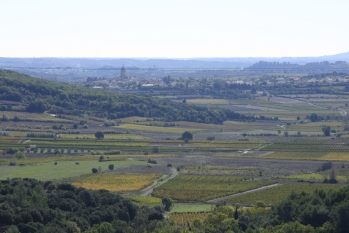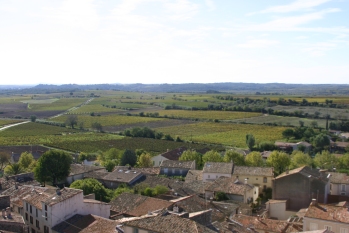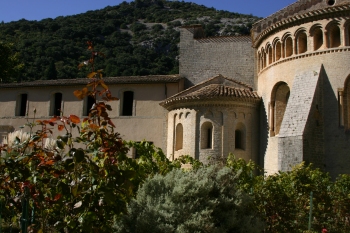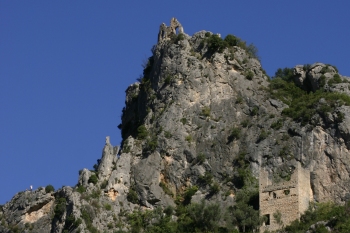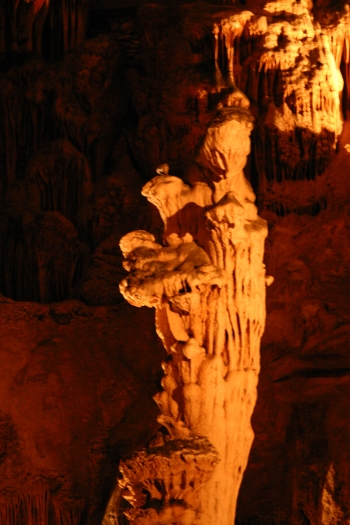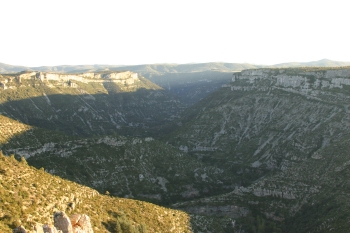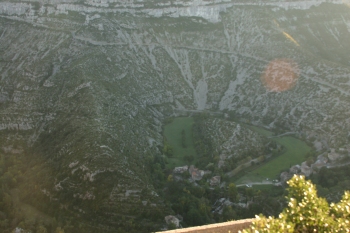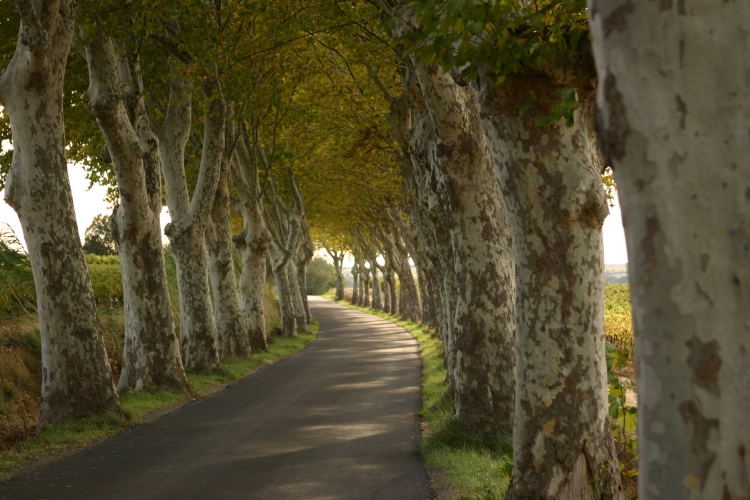The Befouled Weakly News
28 October 2007
- A Foray to France (Part One)
Well, we’re back so it looks like your two week’s peace and quiet is once again shattered by the arrival by the disappointing thud of the Befouled Weakly News onto your virtual doormat. Sorry to say, we had an absolutely glorious time – the weather was bright and brilliantly sunny apart from the final day when we had a bit of cloud and drizzle – and surprisingly, the food and wine was everything we have come to expect from our infrequent excursions to France. We flew on Friday to Perpignan in southern France where we collected a hire car and drove about an hour and a half north to the small town/village of Caux which is where our good friend Joe Jefferies now lives with his delightful (and beautiful) French girlfriend Amandine. They were surprisingly delighted to see us (or at least gave a very convincing performance) and the house they are about half way through renovating was very, very comfortable. Caux is an absolutely delightful village, and is rightly described in the guidebooks as “a jewel of the Languedoc.” It is exceedingly well preserved with narrow streets laid out on a 10th century circular street pattern (“la Circulade”), a defensive arrangement that recollects the troubled and turbulent history of the region. It is about seven km northwest of the town of Pézenas, which is famous for its medieval old town and weekly market. The mountains of the High Languedoc are to the north and to the south, only about half an hour away, the Mediterranean with an abundance of oysters and other shellfish. The Med at Balaruc-les-Bains is one of the three top oyster producing regions in France, much to my delight and Penelope’s dismay. It also boasts some of the best vineyards and wineries in France, many of which rival if not surpass the best that Bordeaux or Burgundy have to offer.
Joe, many of you will remember, is the son of our dear friend Jan Jefferies who we lost to cancer a few years back. He is a keen cyclist and works part-time for French Cycling Holidays with whom we had such a wonderful week in the Dordogne a few years ago. So, on our first full day in Caux we were able to jump on a few bikes and, with Joe’s expert guidance, explore the surrounding towns and villages. We started off gently with a modest twenty-four mile circuit through Neffies, Valihan, along the ridge overlooking the plain with vineyards as far as the eye could see and finally returning to Caux via the village of Fontes. Joe, as a seasoned tour guide, of course, assured us at the outset that there were no real hills to speak of and that the circuit would be about eighteen miles. He certainly hasn’t lost any of his powers of deception; on our ride through the Dordogne he regularly referred to mountains as slight hills and modest undulations and his preliminary description of this circuit was no different. No matter, however, as it was a glorious day with brilliant sunshine and a perfect cycling temperature. We came back contentedly tired and ready to tackle a good meal and a couple of bottles of excellent local wine. Joe barbecued some lamb and we felt surprisingly content with our lot. Day two saw us dragging ourselves out of bed at about 9.00 and, following a hearty breakfast of croissants fresh from the village boulangerie, making our way north to a few sites Joe had recommended. The first stop was the village and abbey at Saint Guilhem-le-Désert about an hour north of Caux. Guilhem the Short-Nosed (how’s that for a descriptive nickname) was a grandson of Charles Martel and hence a cousin of Charlemagne in whose court he served. He was apparently renowned as one of the most valiant warriors of his time. In 793 the Moorish ruler Hisham I proclaimed a holy war against the Franks and attacked the Languedoc, penetrating as far as Narbonne. Guilhem defeated the Moors at Orange and then, in 803, took part in the campaign that attacked Barcelona and won it from the Moors. In 804 he retired to the Abbey of Aniane. (For many centuries it was regarded as entirely laudible for men to abandon their wives and families to become monks) and, in 806, he headed a group of monks who set off to found the Abbey of Gellone (now Saint-Guilhem-le-Désert). Before his death, Charlemagne had given the young Guilhem a reliquary, which was believed to contain pieces of the True Cross. Guilhem left this one to his Abbey, where it remains to this day.
Like many religious and strategic buildings in this part of France, one marvels at their dedication and perseverance – many of these places are built on the top of steep, craggy mountains and Saint-Guilhem-le-Désert is no exception. Although the Abbey and the medieval town is readily accessible, Pen and I glanced skywards to spot the remains of towers and other fortifications on the top-most peaks. Fortunately you can rest assured that we entertained the prospect of hiking to the top not for the slightest moment. From Saint-Guilhem-le-Désert we made our way about another half hour north to Saint Bauzille de Putois and the site of the Grotte des Demoiselles. This region of France is riddled with grottos and this one, the Caves of the Young Ladies, is one of the best. A funicular railway takes you into the caves and then there is a guided tour around the “Cathedral” which measures 52 metres high, 120 metres long and about 80 metres across. There are the usual collection of pseudo-recognisable shapes, most notably the Virgin with the Christ child which, one has to confess, was quite convincing. (Interestingly, when we toured a similar grotto in China, the most widely recognisable shape was apparently that of the Buddha although I think it’s fair to say that a stalagmite collecting over thousands of years is probably more like to resemble the Buddha than the Virgin with child).
After our tour of the Grotte we set off for the Cirque de Navacelles about forty minutes to the west. This is a large, natural amphitheatre-like valley located towards the southern edge of the Massif Central mountain range. The cirque itself was formed by glacial erosion approximately three million years ago and a river, La Vis, meandered through it ultimately creating an oxbow lake within the cirque. Eventually, the lake dried up leaving deposits of silt and peat and thus creating what is the only patch of arable land for many, many miles around. To describe it as stunning doesn’t really do it justice and neither, alas, do our photographs. It was late in the afternoon by the time we got there and the shadows from the setting sun made photographing the cirque from the top moderately difficult.
Driving in France is always “interesting.” Not only do the French drive very, very rapidly but the idea of leaving an appropriately sized gap between themselves and the car in front is clearly a concept with which they are entirely unfamiliar. Add to that the fact that the towns and villages have exceedingly narrow streets which they race through at pace, said streets frequently occupied by old men and/or women watching the world go by as well as any number of stray dogs and you can begin to understand why it’s a bit of an adventure. Even if one is not driving through a town or village their propensity for planting plane trees along the roads generally adds to the excitement of driving. When the trees were planted the pace of travel was considerably more sedentary and there was plenty of room for two carts to pass each other comfortably. Now, as the trees have grown and the size and speed of the vehicles has increased, it’s a bit like driving through an obstacle course having to dodge speeding vans, cars and lorries while at the same time avoiding tearing off one’s wing mirror on the trees at the side of the road. Fortunately, we were able to avoid any altercation and escaped unscathed. On one occasion, driving back into Caux up the very narrow street where Joe lives, there was a dog approaching us in the middle of the road. What to do? No worries, the dog very promptly and conveniently hopped onto someone’s doorstep to get out of our way until we had passed, whereupon he continued his stroll down the middle of the road.
That’s probably enough for one day. I guess you’ll have to wait for next week for the rest of the excursion including a plethora of oysters and assorted shellfish at Balaruc-les-Bains and the amazing Abbaye de Valmagne, another lengthy bike ride, some wine tasting in the Appellation d'origine Controlee region of Faugeres, an excursion to the (artificial) splendour of Carcassonne and the natural splendour of the gorge at Minerve and finally, whilst enroute to the airport at Perpignan, a visit to the Abbaye Lagrasse, the Chateaux de Quéribus and Peyrepertuse, the Gorges de Galamas and finally, after several false starts, the rediscovery of Beryl and Oz’s former home, the Mas, near Tautavel. Et ainsi, pour maintenant, au revoir Greg George and Harriet decided to celebrate their 25th Wedding Anniversary with a trip to Las Vegas. When they entered the hotel/casino and registered, a sweet young woman dressed in a very short skirt became very friendly. George brushed her off. Harriet objected, "George, that young woman was nice, and you were so rude." "Harriet, she's a prostitute." "I don't believe you. That sweet young thing?" "Let's go up to our room and I'll prove it." In their room, George called down to the desk and asked for 'Bambi' to come to room 1217. "Now," he said, "you hide in the bathroom with the door open just enough to hear us, OK?" Soon, there was a knock on the door. George opened it and Bambi walked in, swirling her hips provocatively. George asked, "How much do you charge?" "$125 basic rate, $100 tips for special services." Even George was taken aback. "$125! I was thinking more in the range of $25." Bambi laughed derisively, "You must really be a hick if you think you can buy sex for that price." "Well," said George, "I guess we can't do business. Goodbye." After she left, Harriet came out of the bathroom. She said, "I just can't believe it!" George said, "Let's forget it. We'll go have a drink, then eat dinner." At the bar, as they sipped their cocktails, Bambi came up behind George, pointed slyly at Harriet, and said, "See what you get for $25?" A Brit, a Frenchman and a Russian are viewing a painting of Adam and Eve frolicking in the Garden of Eden. "Look at their reserve, their calm," muses the Brit. "They must be British." "Nonsense," the Frenchman disagrees. "They're naked, and so beautiful. Clearly, they are French." "No clothes, no shelter," the Russian points out, "they have only an apple to eat, and they're being told this is paradise. They are Russian." Statistics show that at the age of seventy, there are five women to every man. Isn't that the damnedest time for a guy to get those odds? His wife had been killed in an accident and the police were questioning Finnegan. "Did she say anything before she died?" asked the sergeant. "Aye. She spoke without interruption for about forty years," said the Irishman. Back to the Befouled Weakly News Back to Greg's Temporary Home Page
|
